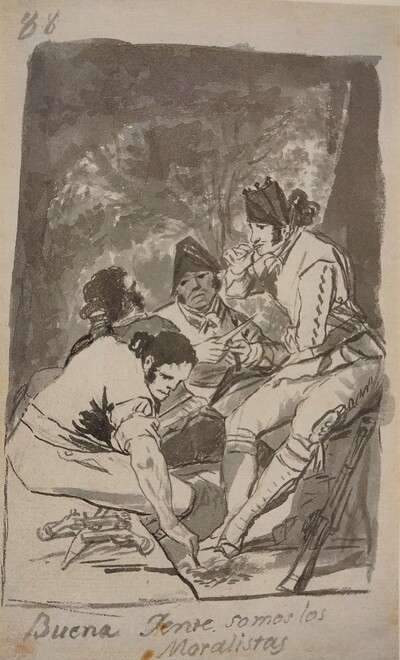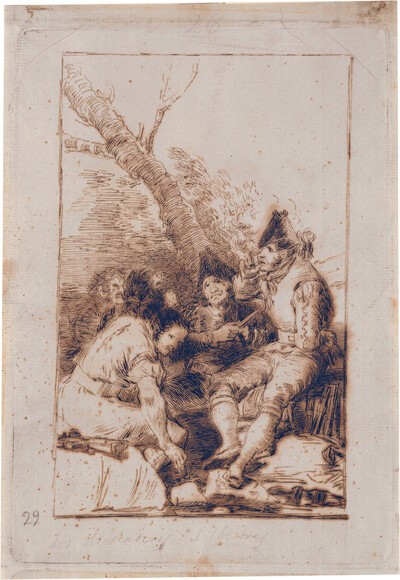- Cronología
- Ca. 1797 - 1799
- Dimensiones
- 219 x 154 mm
- Técnica y soporte
- Aguafuerte, aguatinta bruñida y buril
- Reconocimiento de la autoría de Goya
- Undisputed work
- Ficha: realización/revisión
- 22 Nov 2010 / 29 May 2024
- Inventario
- 225
Boys at the wheel (at the bottom)
11. (in the upper right-hand corner)
See Francisco de Goya y Lucientes, Painter.
The second state proof shows the application of additional aquatint to give shade and to model the figures and the ground. This proof is handwritten with perfect calligraphy Boys at the watering place although the dot on the "i" is ambiguous as it is not clear whether it is a dot or an accent, hence the confusion of the engraver, as two proofs were made in which the word "watering place" does not have an accent.
This engraving is preceded by Dream No. 28 and by a sketch made in Album B or the Madrid Album.
A group of four men, one of them with his back turned, is in a field. One cuts the end of a cigarette with a penknife, another smokes, while the man on the left stubs out a cigarette butt on the ground. A dry tree and some bushes that can be seen on the left side of the engraving form the landscape in which the four male figures stand.
Goya used aquatint for the background of the print to suggest that the scene is taking place at night. He etched the figures in the engraving, leaving relatively large, clean areas on the clothes of the two men in the foreground who capture our attention.
The Ayala manuscript states that "the Andalusian smugglers, near a road, soon become bandits". The Prado Museum manuscript explains this image by pointing out that "the faces and costume are saying what they are". Likewise, the manuscript in the Biblioteca Nacional comments that "the smugglers stalking all those who pass by, near a road, are little different from thieves".
This work, in which Goya may be criticising bandits or perhaps tobacco smuggling, must be related to one of the first tapestry cartoons the painter produced, entitled The Tobacco Guard.
Tobacco smuggling was quite common in that period, as Joseph Townsend (Clare Hall, 1739-1816), who was in Spain between 1786 and 1787, recalls (A Journey Through Spain in the Years 1786 and 1787). According to the Englishman, the government had ostensibly increased the price of tobacco from 30 to 40 reales, which favoured the illegal trade in this product.
Other specialists have interpreted this image as a reference to the servants of the Treasury, i.e. the guards of the Tobacco Resguardo who tried to prevent smuggling and protect the revenue of the Treasury.
The protagonists of this engraving must be related to the bandits who lived in the Andalusian mountains described by William Jacob in 1810 (Travels in the South of Spain). It is also possible that Goya was familiar with the engravings that Antonio Alegre made from the drawings by Antonio Rodríguez, General collection of costumes currently in use in Spain in 1801. In particular, he must have taken a close look at the image of the smuggler, whose clothing clearly resembles the men in the Goya engraving.
The plate is very deteriorated in several areas of the aquatint and etching ( National Chalcography, no. 182).
-
Goya. Gemälde Zeichnungen. Graphik. TapisserienKunsthalle BaselBasle1953from January 23th to April 12th 1953cat. 203
-
De grafiek van GoyaRijksmuseum RijksprentenkabinetAmsterdam1970from November 13th 1970 to January 17th 1971cat. 18
-
Goya y el espíritu de la IlustraciónMuseo Nacional del PradoMadrid1988from October 6th to December 18th 1988. Exhibited also at Museum of Fine Arts, Boston, January 18th to March 26th 1989; The Metropolitan Museum of Art, Nueva York, May 9th to July 16th 1989, Madrid curator Manuela B. Mena Marqués, scientific directors Alfonso E. Pérez Sánchez and Eleanor A. Sayrecat. 43
-
Goya. La década de Los CaprichosMadrid1992organized by Real Academia de Bellas Artes de San Fernando sponsored by Fundación Central Hispano, Madrid, consultant editor Nigel Glendinnig. From October 26th 1992 to January 10th 1993cat. 161
-
Francisco de GoyaMuseo d'Arte ModernaLugano1996exhibition celebrated from September 22nd to November 17th.cat. 11, p.38
-
Francisco Goya. Sein leben im spiegel der graphik. Fuendetodos 1746-1828 Bordeaux. 1746-1996Galerie KornfeldBern1996from November 21st 1996 to January 1997cat. 17
-
Goya artista de su tiempo y Goya artista únicoThe National Museum of Western ArtTokyo1999from December 1st to July 3th 1999cat. 98
-
Francisco Goya. Capricci, follie e disastri della guerraSan Donato Milanese2000Opere grafiche della Fondazione Antonio Mazzottacat. 11, p.19
-
Goya e la tradizione italianaFondazione Magnani RoccaMamiano di Traversetolo (Parma)2006consultant editors Fred Licht and Simona Tosini Pizzetti. From September 9th to December 3th 2006cat. 11, p.148
-
Goya. Opera graficaPinacoteca del Castello di San GiorgioLegnano2006exhibition celebrated from December 16th 2006 to April 1st 2007p.24
-
Goya et la modernitéPinacothèque de ParisParís2013from October 11st 2013 to March 16th 2014cat. 149
-
Hamburg2019cat. 43
-
Goya engravings and lithographs, vol. I y II.OxfordBruno Cassirer1964p.81, cat. 46
-
Vie et ouvre de Francisco de GoyaParísOffice du livre1970p.177, cat. 472
-
La década de los Caprichos. Retratos 1792-1804MadridReal Academia de Bellas Artes de San Fernando1992pp.262-267, cat. 159-163
-
Catálogo de las estampas de Goya en la Biblioteca NacionalMadridMinisterio de Educación y Cultura, Biblioteca Nacional1996pp.79, cat. 99
-
El libro de los caprichos: dos siglos de interpretaciones (1799-1999). Catálogo de los dibujos, pruebas de estado, láminas de cobre y estampas de la primera ediciónMadridMuseo Nacional del Prado1999pp.100-105
-
Bellacos, lisonjeros y amigos de mesa defraudadores de la verdad. Caprichos 11, 12 y 13,Boletín de la Real Academia de Bellas Artes de San FernandoMadridReal Academia de Bellas Artes de San Fernando2001pp.45-65
-
ParísPinacoteca de París2013p. 214
-
Goya. In the Norton Simon MuseumPasadenaNorton Simon Museum2016pp. 42-75
-
HamburgHirmer2019p. 253


